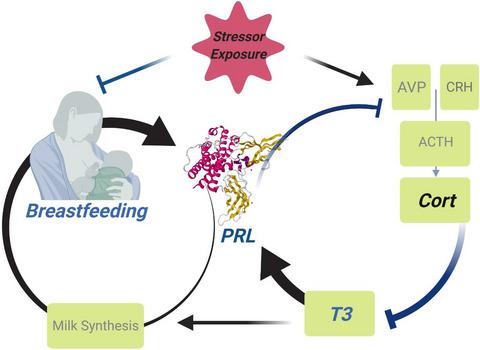当前位置:
X-MOL 学术
›
J. Neuroendocrinol.
›
论文详情
Our official English website, www.x-mol.net, welcomes your feedback! (Note: you will need to create a separate account there.)
T3 is linked to stress-associated reduction of prolactin in lactating women
Journal of Neuroendocrinology ( IF 3.2 ) Pub Date : 2021-06-17 , DOI: 10.1111/jne.13003 Safia Bibi 1 , Mohsin Shah 1 , Muhammad Omar Malik 1 , Ki Ann Goosens 2
Journal of Neuroendocrinology ( IF 3.2 ) Pub Date : 2021-06-17 , DOI: 10.1111/jne.13003 Safia Bibi 1 , Mohsin Shah 1 , Muhammad Omar Malik 1 , Ki Ann Goosens 2
Affiliation

|
The relationship between stress responses and lactation is bidirectional. Breastfeeding confers many benefits to maternal health, including attenuated hypothalamic-pituitary-adrenal axis responsiveness to stress. However, increased stress burden can impair lactation. The mechanisms that underlie these relationships are poorly understood. The present study aimed to compare breastfeeding habits, as well as subjective and objective measures of stress, in employed and non-employed lactating women and assess the relationships between these measures and prolactin (PRL), thyroid hormones (thyroid-stimulating hormone, triiodothyronine [T3] and thyroxine), vasopressin and cortisol levels. A dexamethasone suppression test was also administered to determine the sensitivity of the hypothalamic-pituitary-adrenal axis to negative-feedback. We report that lactating employed women had lower breastfeeding rates and lower PRL than lactating non-employed women. They also had a significantly higher stress burden, indicated by elevations in blood pressure and evening cortisol, relative to lactating non-employed women. In regression analyses that controlled for feeding modality and breastfeeding duration, we found these factors differentially affected PRL in the two groups and there were significant differences in PRL across groups that were not accounted for by these factors. A mediation regression analysis suggested that group differences in PRL were best explained by differences in T3 and income levels, rather than breastfeeding duration or other variables. Our data fit a speculative model in which elevated maternal stress increases cortisol, which suppresses T3, leading to decreased PRL. The decreases in PRL are associated with higher rates of bottlefeeding, which may further contribute to decreased PRL.
中文翻译:

T3 与哺乳期女性压力相关的催乳素降低有关
应激反应和泌乳之间的关系是双向的。母乳喂养对产妇健康有很多好处,包括减弱下丘脑-垂体-肾上腺轴对压力的反应。然而,增加的压力负担会损害泌乳。这些关系背后的机制知之甚少。本研究旨在比较就业和非就业哺乳期妇女的母乳喂养习惯以及主观和客观的压力测量,并评估这些测量与催乳素(PRL)、甲状腺激素(促甲状腺激素、三碘甲状腺原氨酸)之间的关系。 T3] 和甲状腺素)、加压素和皮质醇水平。还进行了地塞米松抑制试验以确定下丘脑-垂体-肾上腺轴对负反馈的敏感性。我们报告说,哺乳期就业妇女的母乳喂养率和 PRL 低于哺乳期非就业妇女。相对于哺乳期的非就业女性,她们的压力负担也显着增加,表现为血压和夜间皮质醇升高。在控制喂养方式和母乳喂养时间的回归分析中,我们发现这些因素对两组的 PRL 有不同的影响,并且在这些因素未解释的情况下,各组的 PRL 存在显着差异。中介回归分析表明,PRL 的群体差异最好用 T3 和收入水平的差异来解释,而不是母乳喂养时间或其他变量。我们的数据符合一个推测模型,其中母亲压力升高会增加皮质醇,从而抑制 T3,导致 PRL 下降。PRL 的下降与更高的奶瓶喂养率有关,这可能进一步导致 PRL 的下降。
更新日期:2021-08-25
中文翻译:

T3 与哺乳期女性压力相关的催乳素降低有关
应激反应和泌乳之间的关系是双向的。母乳喂养对产妇健康有很多好处,包括减弱下丘脑-垂体-肾上腺轴对压力的反应。然而,增加的压力负担会损害泌乳。这些关系背后的机制知之甚少。本研究旨在比较就业和非就业哺乳期妇女的母乳喂养习惯以及主观和客观的压力测量,并评估这些测量与催乳素(PRL)、甲状腺激素(促甲状腺激素、三碘甲状腺原氨酸)之间的关系。 T3] 和甲状腺素)、加压素和皮质醇水平。还进行了地塞米松抑制试验以确定下丘脑-垂体-肾上腺轴对负反馈的敏感性。我们报告说,哺乳期就业妇女的母乳喂养率和 PRL 低于哺乳期非就业妇女。相对于哺乳期的非就业女性,她们的压力负担也显着增加,表现为血压和夜间皮质醇升高。在控制喂养方式和母乳喂养时间的回归分析中,我们发现这些因素对两组的 PRL 有不同的影响,并且在这些因素未解释的情况下,各组的 PRL 存在显着差异。中介回归分析表明,PRL 的群体差异最好用 T3 和收入水平的差异来解释,而不是母乳喂养时间或其他变量。我们的数据符合一个推测模型,其中母亲压力升高会增加皮质醇,从而抑制 T3,导致 PRL 下降。PRL 的下降与更高的奶瓶喂养率有关,这可能进一步导致 PRL 的下降。



























 京公网安备 11010802027423号
京公网安备 11010802027423号